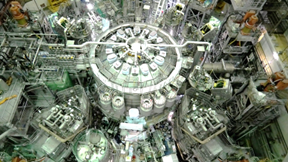


News Highlights
- Cooperation Agreement signed between F4E, QST and GA to provides an advanced diagnostic instrument for the world’s largest tokamak JT-60SA which has been constructed under a joint project between Japan and Europe. This is the first contribution to JT-60SA from an institution outside of Japan and Europe.
- This partnership among these world-leading organisations will significantly contribute to accelerating fusion energy research and development, aiming for the early realization of fusion energy for peaceful purposes.
Abstract
Fusion For Energy (Director: Marc Lachaise; hereinafter referred to as "F4E"), the National Institutes for Quantum and Science and Technology (President: Shigeo Koyasu; hereinafter referred to as "QST"), and General Atomics (Vice President, Magnetic Fusion Energy Division: Wayne Solomon; hereinafter referred to as "GA") have announced the signing of a new agreement to cooperate in the field of fusion energy research and development with the participation of GA on the Satellite Tokamak*1 Programme JT-60SA*2 as part of the Broader Approach Activities*3, which is a joint project between Japan and Europe aiming for the early realization of fusion energy for peaceful purposes.

JT-60SA
Under this agreement, GA will provide an advanced diagnostic instrument for energetic particles in the world’s largest superconducting tokamak JT-60SA. This is the first contribution to JT-60SA from an institution outside of Japan and Europe. The instrument, developed through cutting-edge research at GA, will provide critical information on energetic particles in fusion plasmas by measuring the Fast-Ion Deuterium-Alpha emissions*4. The obtained information will be key in understanding the dynamics of energetic particles in fusion plasmas The energetic particles play an important role to plasma heating, current drive and overall performance because they are a key source of energy and momentum. The instrument will be operational in JT-60SA during plasma heating experiments starting from 2026.
GA experts will participate in the experiment by operating the diagnostic instrument and sharing measured data. The exchange of scientific knowledge will foster mutual growth among the experts in F4E, QST and GA, thereby accelerating the development of key technologies required for the early realization of fusion energy.
F4E, QST and GA have been strong contributors to international initiatives such as the ITER project*5 and their respective DEMO*6 programmes aimed at achieving commercially viable fusion energy. The new cooperation agreement on JT-60SA with a strong partnership among these institutions marks a significant step toward advancing fusion energy research globally, with the ultimate goal of delivering clean, abundant, and sustainable energy for future generations.
Glossary
*1…Tokamak
A method of confining high-temperature plasma using a magnetic field: A high-temperature plasma is confined by combining a circumferential toroidal magnetic field produced by the external coils, which is the main magnetic field, with a radial poloidal magnetic field created by passing a circumferential current in the plasma. ITER also uses a tokamak-type device.
*2…JT-60SA (JT-60 Super Advanced)
As a joint project of the satellite tokamak jointly implemented by Japan and Europe as a Broader Approach (BA) activity and the tokamak domestic priority device project that has been under consideration in Japan, the device was constructed at the QST facility in Naka City, Ibaraki Prefecture, Japan. This is the world's largest tokamak-type superconducting plasma experimental device as of today. Its purpose is to support research for ITER to achieve its technological goals and supplementary research for ITER toward DEMO reactors and human resource development. JT-60SA uses powerful superconducting coils cooled to approximately -269 degrees Celsius (absolute temperature approximately 4K) to confine plasma that can reach 100 million degrees Celsius of temperature.
URL: https://www.jt60sa.org/wp/
URL: https://www.qst.go.jp/site/jt60/5150.html (Japanese)
*3…Broader Approach Activities
The Broader Approach (BA) Agreement, concluded between the European Atomic Energy Community (Euratom) and Japan, consists of activities that aim to complement the ITER project and accelerate the development of fusion. The work includes the construction of an advanced fusion device, research into durable materials for use in future devices, and preliminary work on the future Demonstration (DEMO) reactor.
URL: https://www.ba-fusion.org/ba/
*4…Fast-Ion Deuterium-Alpha emissions
The fast-ion deuterium-alpha diagnostic is an application of charge-exchange recombination spectroscopy. Fast ions that neutralize in an injected neutral beam emit Balmer-alpha light with a large Doppler shift.
*5…ITER Project
With the international cooperation of seven Parties: Japan, Europe, Russia, the United States, China, Korea, and India—the project aims to demonstrate the scientific and technological feasibility of fusion energy through the construction and operation of ITER. The target of the project is to obtain fusion energy that is 10 times larger than the input energy of the external heating system (Q≧10). Currently, the site is in Saint-Paul-les-Durance, France, and the ITER Organization, an international organization for the project implementation, is leading the construction of buildings and the assembly of components for the start of operation. Also, the manufacturing of various ITER component devices has been advanced by each of the seven parties.
*6…DEMO
A DEMO reactor is a next-generation device that will demonstrate the power generation and economic feasibility of fusion energy. Currently, conceptual designs for DEMO reactors are being developed in various countries around the world.
